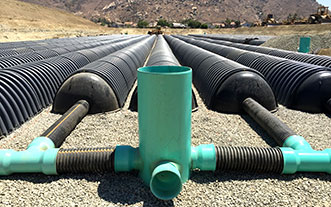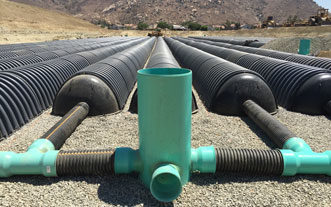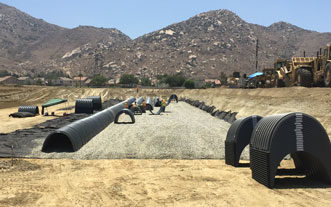Prinsco Stormwater Collection and Infiltration System Featured in June 2017 Stormwater Magazine

August 2, 2017
Stormwater Magazine recently showcased Prinsco products in a June article titled “Taking Stormwater Storage Underground.” The Citrus Commerce project, located in Fontana, CA, used Prinsco’s HydroStor HS 180 stormwater chambers to create collection and infiltration areas for three distribution centers, drive aisles, and semi-trailer parking areas. Read about the Prinsco project below or read the entire article on the Stormwater Magazine website.
Southern California Infiltration
Thienes Engineering, based in La Mirada, CA, designed a stormwater collection and infiltration system for the 77-acre Citrus Commerce master plan in Fontana, CA. Per the San Bernardino County MS4 permit requirements, the runoff of a 24-hour, 85% percentile storm event must be infiltrated, harvested and reused, evapotranspirated or biotreated. Accordingly, runoff from Citrus Commerce’s three distribution centers, drive aisles, and semi-trailer parking areas collects in six underground Prinsco’s HydroStor HS180 polypropylene infiltration areas. Each Citrus Commerce building and hardscape occupies different sized areas, which results in custom-sized infiltration areas.
Luke Lacy, estimator with S&S Douglas Pipeline in Lake Elsinore, CA, supervised construction of the Citrus Commerce infiltration systems and appreciates Prinsco products. “Any size can be made and Prinsco will do the layout for you,” says Lacy.
S&S Douglas has installed numerous infiltration systems like the one in the Citrus Commerce project. “We’re using them the most in big industrial areas and distribution centers with huge parking lots,” he says.
Prinsco manufacturers infiltration chambers in two sizes, the HS180 and HS75, with 180-cubic-foot and 75-cubic-foot capacity, respectively. Designed with an open bottom, the Prinsco chambers sit on top of appropriate bedding material and allow water to percolate into the subgrade below. Individually manufactured chambers can be connected in series to form larger infiltration areas of varying length and width, and multiple infiltration areas may be linked together by pipes. Prinsco and similar pipe-based systems can be significantly more cost effective but their finite installation depth means increasing volume capacity may only occur horizontally. For large runoff areas, storage volumes may require relatively large subsurface planes, like the extensive parking stalls and drive aisles of a distribution center.
The City of Fontana required pretreatment to be applied to each infiltration area, so Thienes specified a hydrodynamic separator with manhole access at each to facilitate periodic garbage and sediment removal.
Because of the high real estate costs, Citrus Commerce developers selected underground stormwater infiltration to use all property areas for higher value land uses. The infiltration areas reside mainly under parking and trailer stalls, but due to property constraints like utility lines, some infiltration lies under drive aisles.
Both Prinsco HS180 and HS75 chambers meet AASHTO HS-20 loading requirements. “They’re under the parking lots with semi-trucks parked on top of them, so they’re rated to handle a lot of weight,” explains Lacy. He finds the pretreatment and infiltration capabilities of underground systems to be impressive. “All that garbage that would have gone into the rivers and oceans gets trapped on site and cleaned out. With that large a site, the stormwater system typically has an overflow and doesn’t recharge the water table. To be able to [retain] all that water onsite is amazing.”
Cessna, Janice. “Taking Stormwater Storage Underground.” Stormwater Magazine. June 2017.

